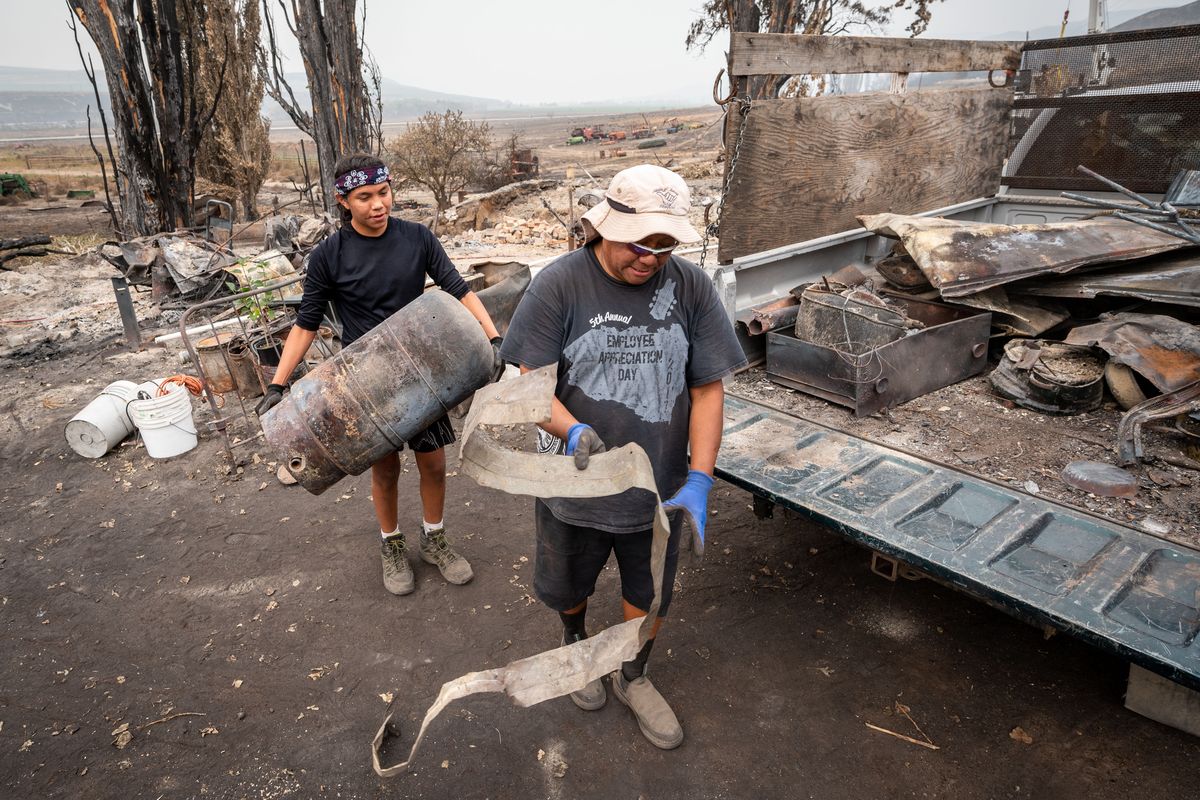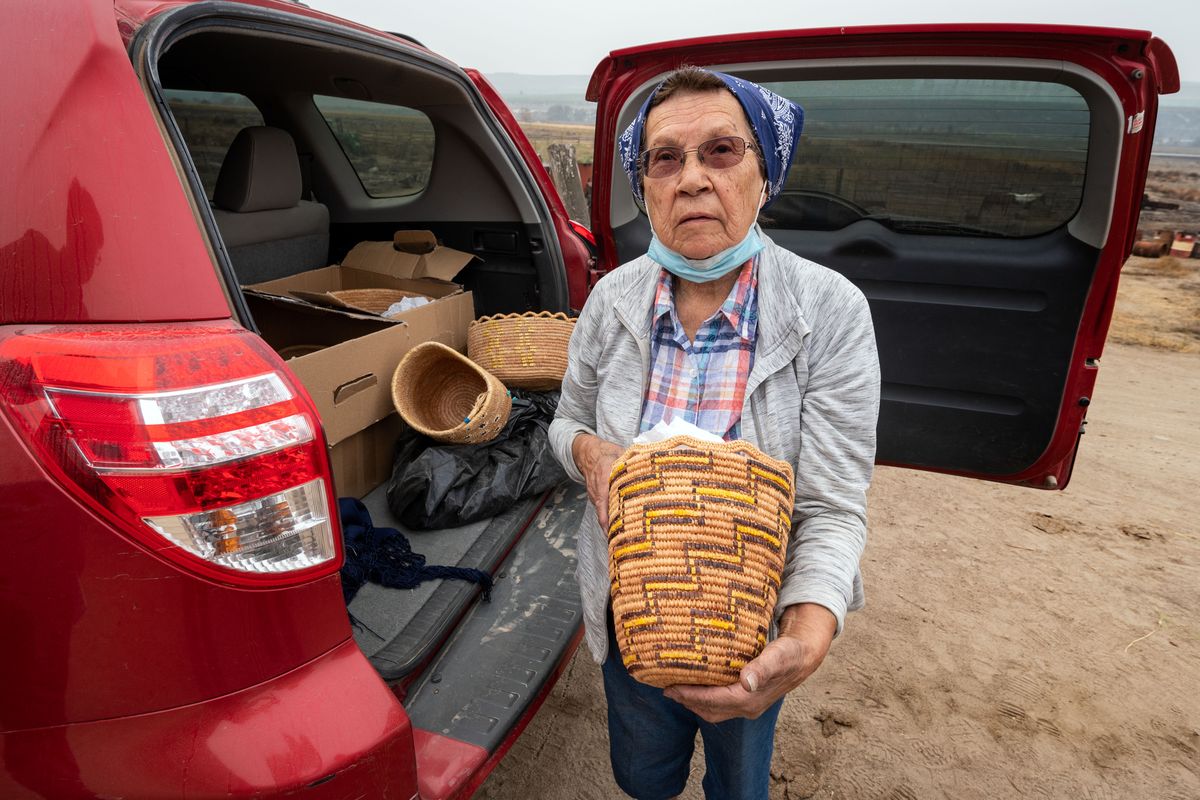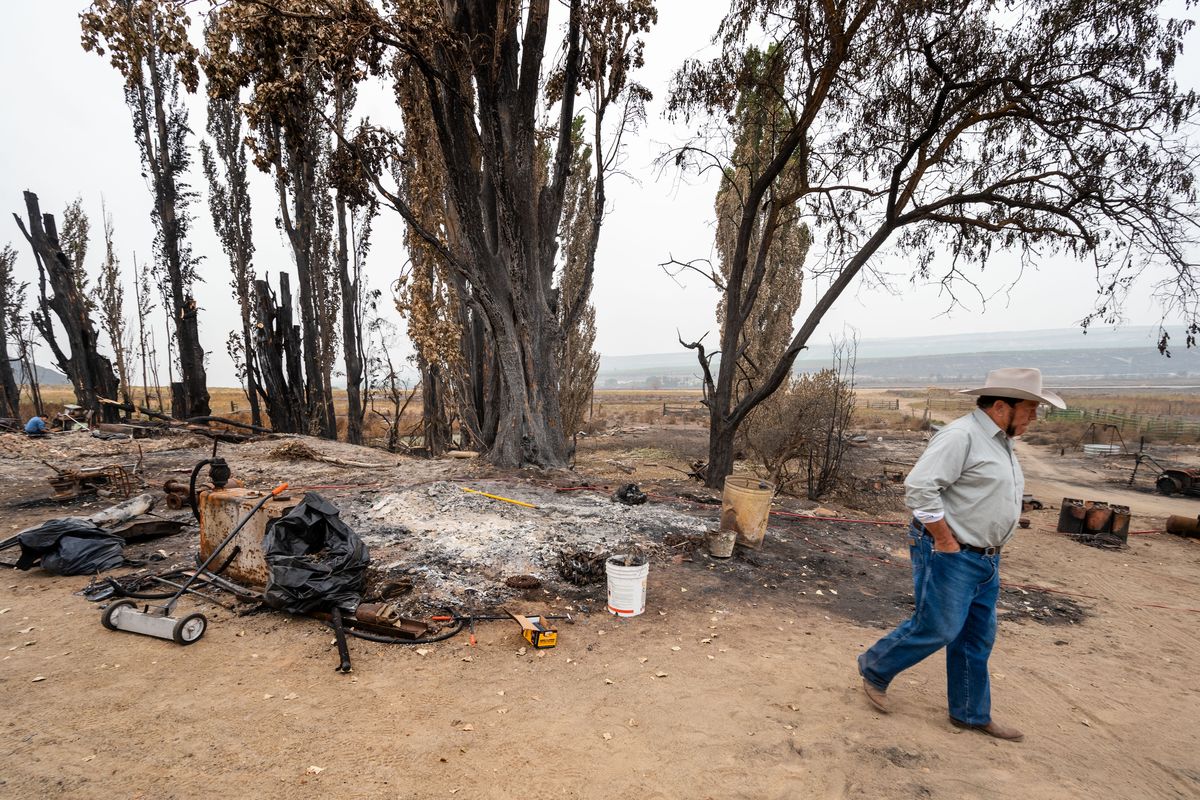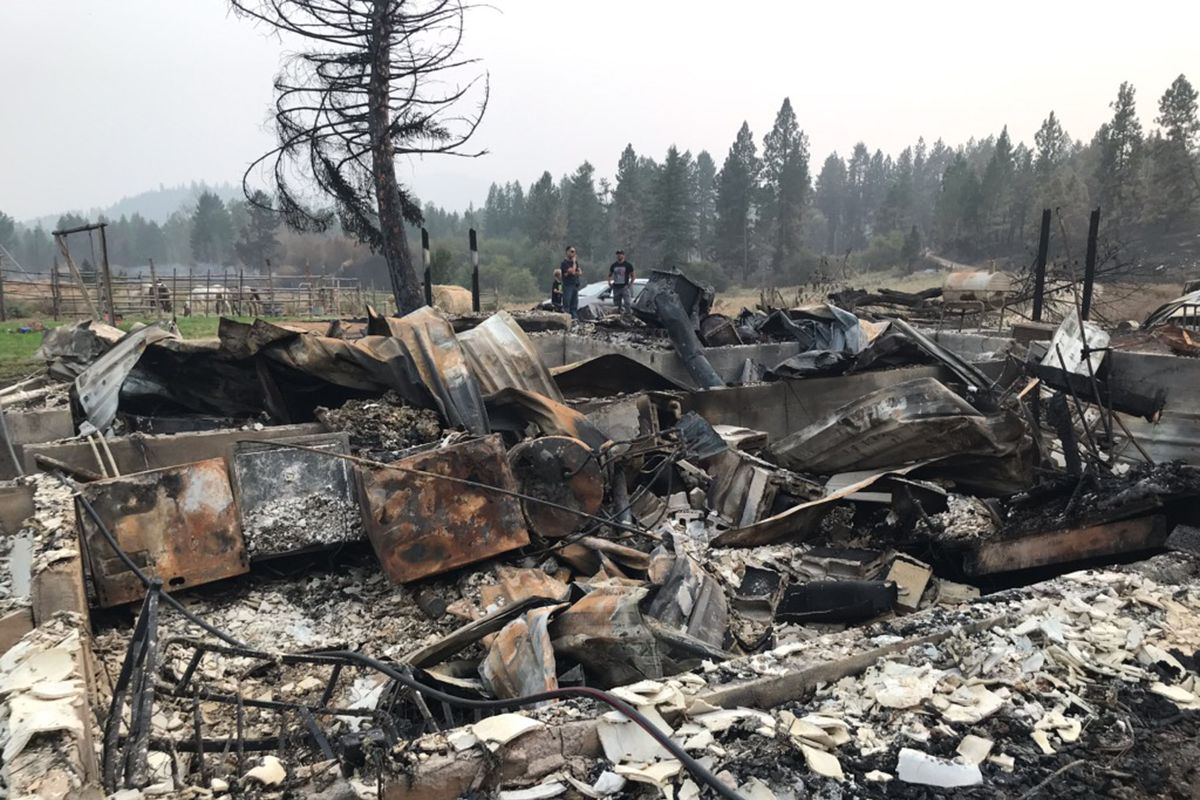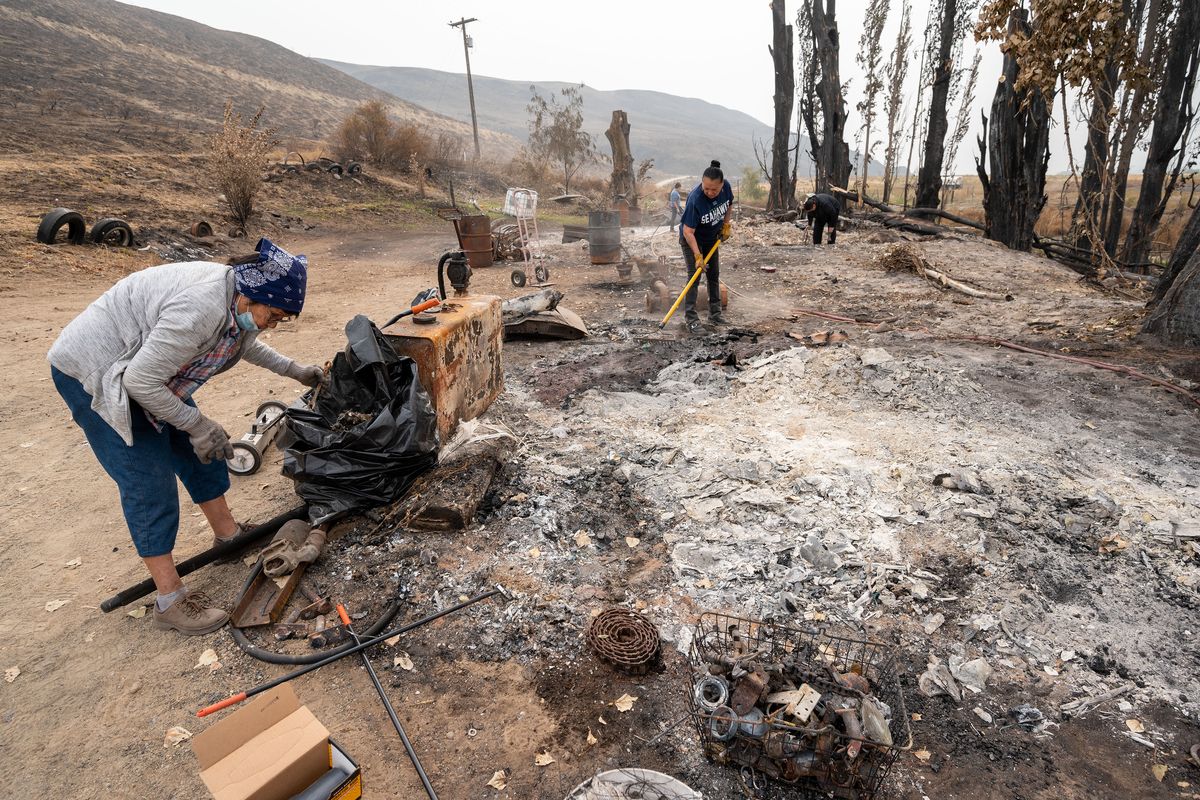‘Burnt, like I am’: After fires burn through Colville Reservation, efforts underway to recover, adapt
“The reality is I still have a home, but it’s just ashes,” said Jimmy Timentwa, at the site where his house was destroyed in a fast-moving wildfire in early September during the Cold Springs Fire near Omak. “I’m living in the dirt now,” he said. (COLIN MULVANY)
MONSE, Wash. – When the fire roared down the western edge of the Colville Reservation, Jimmy Timentwa jumped in the 2002 cherry red convertible Corvette he won in a casino drawing and left the cattle ranch that has been in his family for a century.
“The reality is I still have a home, but it’s just ashes,” said Jimmy Timentwa, at the site where his house was destroyed in a fast-moving wildfire in early September during the Cold Springs Fire near Omak. “I’m living in the dirt now,” he said. (COLIN MULVANY)
Behind him came his sister, Elaine Timentwa Emerson, the back of her SUV filled with a sample of the traditional handwoven baskets she has devoted much of her life to laboriously crafting and teaching others to craft, some of which have found their way into museum and private collections.
Their two-car caravan made it down the dirt ranch road and started south on Highway 97 toward Brewster, where Timentwa intended to drop his “pride and joy” off for safe-keeping with a trusted mechanic.
“I had to save something,” Timentwa said. “So, basically, I took it down there in case we did burn and I could come back and rebuild, because I might end up selling it.”
But before they’d made it the few miles to the tiny town of Monse, “the fire was hanging over that ridge,” Emerson said, gesturing toward one of the low, sweeping and blackened hills in the near distance.
“So I thought, ‘They’re not going to let us back in,’ ” Timentwa said. “So I turned around and I drove back, and I don’t know where I was going, and we ended up making our stand in that cemetery down there.”
It was there, in that cemetery, with a pristine Corvette and a trunk full of valuable Native art, that the siblings with deep roots in the Okanogan and Methow bands of the Colville Confederated Tribes watched a fire Elaine described as “a monstrous thing” sweep in and decimate nearly everything they owned.
“We’ve had fires around here, range fires,” Emerson said. “We know that, but not like that.”
“This one here moved; it had a sound, it had a feel,” Timentwa elaborated. “And when it came through here, it looked like it was about 9 o’clock at night and it was pitch dark. You didn’t know where the fire was. It made a noise that you wouldn’t believe, like a big semi truck going by. I mean, she was a whoopin’ and a poofin’, and then it had those old big spirals that would stand up and the wind would catch it and it would run 50 or 60 yards.
“What was really weird is the wind would blow from the east, then from the northeast, then it would shift from the south,” he continued. “The whole air looked white. Everything looked white and eerie and it made a sound.”
“And it was dark like night,” Emerson said.
“You could see that whirling smoke and all of a sudden you heard this big poof and it was just a red ball of fire and it’s reaching out with tentacles,” Timentwa said. “And the heat. I’m sitting maybe 100 feet from the highway and I can feel the heat and my Corvette’s sitting in front of me and I’m going, ‘Oh (expletive), with that epoxy, it’s going to ignite.’”
‘Left to burn’
The wind had taken down the phone lines, so Lonnie Cawston first heard via text about the fire that would eventually jump the Columbia River, consume more than half-a-million acres and burn through the Timentwa ranch .
When Cawston, the fuels planner and acting lead for the Colville Tribe’s Mount Tolman Fire Center, got the message, it was 9 p.m. the night before Labor Day.
He immediately headed from his home in Coulee Dam to Omak. On his way, a coworker texted to say two more fires had started near the town that sits on the reservation’s far western edge.
The local fire department was on scene when he arrived, Cawston recalled, but the “fire was already 20 acres” and was moving at “incredible speeds,” propelled by winds that were switching directions rapidly and unpredictably.
While Cawston and local crews worked to try to attack the fires, he already knew reinforcements would be required.
“We knew the thing was out of control,” Cawston said 10 days later, at the fire’s Incident Command Post on the Omak Stampede grounds. “It was moving faster than we could engage with the resources we had.”
As he worked with other local fire officials to request resources from the state, Cawston also changed the focus on the ground, turning crews’ focus toward “point protection” in an effort to safe people and structures.
“And then the thought was just trying to get everyone out of the way,” Cawston said.
That meant shutting down highways, implementing immediate Level 3 evacuations and initiating Okanogon County’s emergency response.
“There was no messing around,” he said. “Just get people out.”
Despite the severity of the situation, Cawston said the number and size of the fires raging across the West that weekend meant it was difficult to get crews and equipment to come.
And a bad situation got much worse the next morning, when three large fires erupted some 90 miles east, on the far side of the reservation, around the town of Inchelium.
With Omak and Inchelium both facing fires that would come within about a half-mile of each, Cawston was faced with an impossible decision.
On one hand, he said, he felt like he “had to” divert some crews and equipment to the far side of the reservation. On the other hand, “there was no resources available.”
“There just was not enough resources to respond to Inchelium,” Cawston said.
It wasn’t just Mount Tolman that was strapped. It was the entire national infrastructure for wildland firefighting.
Dean Kiefer, incident commander for the Cold Springs Fire, said he too was stymied in his efforts to call in crews and equipment.
“After a couple days,” Kiefer said, “we figured we’ve just got to suck it up and make do with what we got and not trying to keep ordering stuff.”
With only about a third of the usual number of firefighters battling the blazes near Omak, the scant crews based in Inchelium were largely left to do their best without reinforcements, except for the help offered by local residents.
“We were left to burn,” said Joel Boyd, vice chair of the Colville Business Council and a representative from Inchelium. “It was up to the town to defend itself.”
Boyd said he saw as many people rushing toward the Inchelium Highway Fire – one of three that formed the local complex of fires – to help as he saw fleeing. He was among those who tried to help people pack, evacuate and defend their homes.
“I think a lot more homes would have been lost if it wasn’t for the people here,” he said.
People like Curtis Clark, who said he awoke Labor Day morning with no power and news of what would become the more than 11,000-acre Kewa Fields Fire near Inchelium.
While resources were slow to come due to “all the other fires,” Clark said, he worked with neighbors to do whatever they could to save homes in the area, throwing dirt on the flames with a shovel before setting little back fires around his home with leftover propane to burn brush before the wildfire could consume it.
Eventually, he said, local firefighters plowed in a fire break, brought a pumper truck and helped him save his home, which is built on land where he grew up and that he said has been in his family for 100 years, since the reservation was established.
“We are one of the fortunate ones,” Clark said.
Aaron Sutton and his two kids were among the less fortune ones.
“It was pretty much raining fire,” Sutton said 10 days later. “Everything just started lighting on fire.”
Among the things on his property that caught fire were two campers, hay, a barn, a horse trailer, a shop full of tools and numerous vehicles.
“I was praying that the horses would make it, that the house would make it,” said Sutton, a member of the Spokane tribe.
The horses did make it, but they were about all that did.
Sutton tried to save the house long after a friend took his children away to safety, but even its loss became “inevitable,” he said.
“It was too late,” he said, standing with his nine-year-old son, Solace, before the charred and twisted remains of the house he lived in for a decade once stood. “There was nothing I could’ve done.”
‘Fire can be healing, too’
Sutton’s journey back from losing everything got a major boost in the parking lot of the Omak Walmart, where a donated sedan was waiting for him.
A couple from Winthrop donated the car, but it was the River Warrior Society – a recently formed Spokane-based nonprofit comprised of canoe families from the Colville, Spokane, Kalispel, Nez Perce, Coeur d’Alene and Kootenai tribes – that identified Sutton’s need and found someone to fill it.
Sutton called the connection “a huge blessing,” and it’s one of countless such acts of comfort and aid performed by the society since fires started on the Colville Reservation.
The Cold Springs fire destroyed 78 primary and 60 secondary structures, according to a preliminary estimate from Douglas County, before it jumped the Columbia River, which serves as the Colville Reservation’s southern border, and continued to burn. Along the way, it took the life of a one-year-old and seriously injured his parents, who were discovered near the Timentwa ranch.
The three fires of the Inchelium Complex destroyed four primary residences and damaged nine secondary buildings, according a preliminary estimate in Ferry County.
But the impact on the Colville Tribe was vastly more expansive – and will be longer lasting – than those numbers suggest, according to Bobbie Mollenberg, a River Warrior Society member who has driven back and forth between Inchelium and Omak countless times, bringing supplies directly to those who need them.
“Your day-to-day gets taken away,” she said, “from cooking your food to brushing your teeth.”
On both sides of the reservation, from Omak to Inchelium and many points in between, she and other members of the society have been coordinating an expansive effort to help those whose lives have been upended by fire.
They’ve solicited donations, set up distribution centers and gone door to door, gauging the needs of those affected and finding ways to meet them. They’ve provided people in need with gas cards, cash, campers and hotel rooms. They’ve given out blankets, clothes, toiletries, propane and hay.
They even “put a call to our tribal hunters and fisherman” to help restock the freezers of elders who lost their supplies of game when the power went out, according to Faith Zacherle, who has been working with her fiance, Robert Tonasket, to lead the society’s effort in Omak.
During twice-daily Zoom meetings, Zacherle said, they’ve coordinated about the specific “needs and wants” of families and about how to meet them.
“We get so many calls a day for help,” Mollenberg said. “It’s hard to get to everyone who needs help.”
The society has hardly been working alone in the effort to aid those affected by this year’s fires. Donations have poured in from off the reservation, and people and organizations on the reservation have banded together to offer each other different kinds of aid, whether its the tribe helping people find new housing or a neighbor helping a neighbor rebuild a fence.
“The way that we join together on this reservation is indescribable,” Mollenberg said.
Together, she said, residents have been able “make things out of trauma.”
“It’s weird how fire can be healing, too,” said Shelly Boyd, a member of the society in Inchelium.
‘The land is ours’
While Timentwa’s Corvette didn’t ignite in the cemetery, nearly everything else he and his sister owned did go up in flames on the other side of Highway 97.
A barn full of Timentwa’s tack. A shop full of his tools. A shed. A tractor. A pair of Japanese motorcycles. A small fraction of Jim’s herd of cattle, found “charred and blackened.” The ’74 Chevrolet pickup that was Timentwa’s reliable ranch vehicle for some 40 years, ever since he found it in a Coulee City garage.
And both of their houses, each reduced to ash.
Plus everything inside them, including a seemingly priceless trove of crafts, artifacts and research into the history of their ancestral roots in the Methow Valley, before Indigenous people were driven off the land and onto the Colville Reservation.
There were buckskins and blankets and beadwork and baskets. There was a filing cabinet filled with their mother’s notes about “where her people came from, where they lived, where they camped, where they’re buried,” Emerson said.
The siblings were still sifting through the reality of all they had lost on a recent afternoon, but they were also hanging onto the few things they had been able to salvage.
Timentwa’s Corvette for one. Emerson’s baskets for another. A John Deere tractor that had inexplicably been spared for a third.
But perhaps most important of all was what was spread out already around them, even if it was badly burned.
“I felt probably a lot better than I should’ve about it, because the land is ours,” Emerson said. “I could come home to it, it’s mine. I don’t have to be on a street corner, not knowing where I’m going. And all of these teachings and everything we were taught come to life.”
The night their material life went up in smoke, Emerson asked her brother, “Where do we go? What do we do?”
“And I says, ‘The car garage is still up,’” Timentwa recalled.
The Corvette saved and the garage where it’s usually stored among the few things spared on the ranch, the siblings removed the floor mats and tried to sleep inside the uninsulated structure.
“Sleeping wasn’t easy,” Timentwa said, “because you didn’t have blankets and we’re basically sleeping on the ground.”
As they lay there exhausted but restless, Emerson said she listened as the “embers would burn and go down all night long.”
Over the next 10 days, the two have continued to remain on their land, taking it day by day.
The important thing, Timentwa said, has been to focus on what’s in front of them, to ask “What do you need for today?” and then to find a way to meet those needs.
They’ve done so with help from a wide array of friends, neighbors and tribal officials.
“I’m surprised where help comes from – and how much,” Timentwa said.
As he talked, Karen Condon, who represents the Omak district on the tribe’s business council, and her sister Margaret Neely were helping sift through the ash and rubble of Timentwa’s home.
The assistance has allowed the siblings to stay in somewhat more comfort on their land, where they’re temporarily living in a donated motor home.
Even so, it’s not an ideal living situation: two elders in an RV, with an improvised patio made from tarps set up outside, ants crawling up through the seams.
“Now I’m living in a goddamn sardine can, living in the dirt,” Timentwa said. “My whole world, just poof.”
‘Burnt, like I am’
Looking back, Timentwa said, “You realize that you don’t own nothing.”
And his efforts to hang onto the one thing that he thought he could count on – the land – have eluded him.
“You got so mad,” he said, “that you said, ‘Mother Nature’s a bitch.’ ”
In search of solace, he said, he went to a place where he has often found it: nearby Soap Lake.
“See, us Indians are tied to the land,” he explained. “I went up to Soap Lake to kind of get support, emotional support. Washed my hands and face like we were taught, and I thought, ‘What the hell am I doing up here? The land’s dead. What kind of help can I get? It’s burnt, like I am.’ ”
Timentwa is not the only one frustrated by the effort to understand the scarring of about 15% of the tribe’s 1.4 million acres of reservation land, which represents a small fraction of the Colville Tribes’ traditional territory.
That territory – which was occupied by the Chelan, Chief Joseph Band of Nez Perce, Colville, Eniat, Lakes, Methow, Moses-Columbia, Nespelem, Okanogan, Palus, San Poil and Wenatchi bands that compose the Confederated Tribes of the Colville Reservation – stretched from the Blue Mountains in northeastern Oregon to the Okanagan Highland of British Columbia.
Sitting across from his brother Lonnie at the Omak Stampede Grounds, Rodney Cawston, chairman of the Colville Business Council, said he’s been trying to understand the forces that led to this month’s expansive fires and that he fears could make them more common.
“It was a very atypical year,” Rodney said on a recent morning. “Or at least I would like to think so.”
“Something’s changed,” Lonnie said. “I’ve never seen anything like this in my life.”
While experts “can’t attribute any one fire or any one fire season to climate change,” Crystal Raymond, a research scientist with the University of Washington’s Climate Impacts Group, said the expansive fire that started outside Omak and spread over hundreds of thousands of acres is “definitely part of a trend that’s consistent with warming.”
That trend, she said, includes wetter winters and springs that “create a lot of grass vegetation” and hotter, dryer summers that prime all that vegetation to burn.
“That’s a perfect setup for fires” in the sagebrush ranchland that spans so much of Central Washington, including parts of the Colville Reservation,” Raymond said. “So when fire burns, like the ones that burned this year, there’s a lot more fuels to carry the fire.”
And the conditions that have led to larger fires are likely to worsen in the near future, according to a recent assessment conducted by the Colville Tribes Natural Resources staff in partnership with the Climate Impacts Group.
“Warmer, drier summers and earlier snowmelt are expected to increase the area burned in eastern Washington by two to four times by the 2080s,” the assessment says. “The actual area burned and the effects on vegetation will depend on past fires, future changes in vegetation, and land and water management actions.”
Rodney Cawston said he’s focused on taking the actions that can help spare the tribe what it experienced not only this year but also in 2015, when fire burned through about 20% of the reservation, including about a third of its commercial forests.
“That’s where my mind is going,” he said. “The way we look at fire management, how should that change?”
He said the tribe is looking at “how we can move and reduce fuel,” how to prepare residents better in the event of future evacuations and how to educate people about protecting their homes ahead of time, especially as more people build on increasingly vulnerable lands.
Cawston said he has also been pursuing a plan to use the reservation’s timber, much of it fire-damaged, to create renewable fuels.
“It may not pencil out, may not be profitable,” he said, “but we have to look at the cost of not doing anything.”
The cost of the 2015 fires is still being felt, he said, in the form of lost timber sales and lost timber jobs.
And he said those financial impacts will reverberate “for a long time.” He’s also concerned the millions the tribe has invested to plant new trees and restore those lands could go up in smoke if they burn again.
Cawston said he’s also focused on bolstering the tribe’s firefighting capacity, primarily through improving “access to aerial equipment” for fighting wildfires that do erupt.
Currently, the tribe relies on state and federal agencies for that support, which sometimes leaves tribal crews without that critical resource. But Cawston said he’s working with other tribes to create a shared, centrally located arsenal of aerial resources to fight reservation fires.
But fire isn’t the only recent weather-related challenge the tribe has faced.
Citing a litany of recent hardship, including “really extreme weather temperature,” ice storms, mud slides and a severe drought that led the governor to declare a state of emergency, Cawston said his tribe is the “poster child for climate change.”
“So there seems to be this imminent threat that seems to keep growing more and more every year,” Cawston said.
“It just seems like we have to look at doing things in a different way,” he added.
Doing so will be key for people like Timentwa and Emerson, who lost almost everything but were back on their land within hours, who have no plans to leave, and who have sought solace in the few things they saved from destruction.
While Emerson showed visitors the baskets stacked in the back of her SUV, Timentwa offered a peek inside his garage at his Corvette – as well as a vision for getting it back out on the road soon.
“Couple afternoons, I’ll drag my Corvette and wash it and cruise,” Timentwa said. “Drop the top, put in some top 40 hits.”
Editor’s note: This story has been updated to correct the name of the River Warrior Society.
